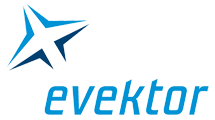Evektor spol. s r.o. (Ltd.) is a private commercial organization with about 200 highly-educated and skilled specialized engineers. Certified by EASA as a Design Organization, it is a leading design company in the Czech aerospace industry covering complete product development, testing and certification including installations of avionic systems and their protection against electromagnetic environmental effects. Its earlier successful participation in other aerospace projects (Raven, Aero L159, Aero270, VUT100) has flown into a contraction of its own project EV55- twin-engine turboprop with using of modern composite materials. We can find other essential design and engineering activities of Evektor also in automotive and other industries in the Czech Republic as well as in other countries.
Evektor is a pioneer in use of various computational models and virtual testing of their behavior under an action of a physical reality. Finite element method (FEM) has been used in Evektor especially for structural analysis (mechanical strength) calculations since 1995. These activities were begun by a hire engagement in some aircraft projects of Aero Vodochody as well as other airframmers (Raven of Wolfsberg Aircraft Co.) and continued by its involvement in the Czech automotive industry (Skoda-Volkswagen) since 2000 up to now.
More than 12-year’s experience of Evektor in a creating of FEM models for mechanical engineering made possible to extend its activities also into the Computational Fluid Dynamics (CFD). The fellows of automotive crash simulation department were the first pioneers using the ANSA universal meshing preprocessor as the most powerful and effective tool for the FEM models’ preparation. Having taken into consideration the best experience with the FEM models’ preparation for the years and previous involvements of the electric and avionic systems’ installation department in experimental EMC certifications on various Czech aircraft development projects, there was made a logic decision of the top management, to extend engineering activities of Evektor into the CEM field. This goal was reached by a cooperation of Evektor with the Department of Radioelectronics at the Brno University of Technology and other partners in 2007-2010, when a financial support for the project ARTEMIS (Analytic Research of Threats in ElectroMagnetically Integrated Systems) was provided to the consortium within the TANDEM Research and Development Program of the Ministry of Industry and Trade of the Czech Republic.
Thanks to the above mentioned effort, Evektor is able to create 3D electromagnetic models of its aircraft with a high geometric and material complexity and to carry out CEM simulations in time as well as frequency domain on them. The know-how obtained by the above mentioned cooperation is used also at the involvement of Evektor as well as Department of Radioelectronics in the large European cooperating project HIRF-SE.
SIX center cooperation
A former cooperation of Evektor with DREL FEEC (SIX participant) is dated from 2007 up to 2010, when a grant for the common project ARTEMIS (Analytic Research of Threats in ElectroMagnetically Integrated Systems) was provided to the partners within the TANDEM Research and Development Program of the Ministry of Industry and Trade of the Czech Republic.
Contact
| Company | Evektor, spol. s r. o. |
| Address | Letecká 1008, 686 04 Kunovice, Czech Republic |
| Web | www.evektor.cz |
Contact person
| Name | Pavel Tobola |
| Phone | +420 572 537 454 |
| ptobola@evektor.cz | |
| Profile | Pavel Tobola (1954) coordinates activities of the new established EMC&CEM work group suitably extending activities of the electrical engineering and design department of Evektor, spol. s r. o. engaged in installations and cable bundle designs for airborne electrical and avionic systems on small aircraft and their certifications with reference to the safety and reliability. The EMC&CEM work group examines problems of undesirable affecting of individual systems each to other as well as their protection against electromagnetic environmental effects (high intensity radiated fields and indirect effects of lightning) especially using simulating calculations of electromagnetic fields and their responses in cable bundles. Pavel Tobola received his Ing.(M.Sc.) and CSc.(Ph.D.) degrees in the field of radioengineering from Brno University of Technology. He started his work carrier at the calibration laboratory of electrical quantities (RF and modulation meters´ and generators´calibrations) at the former avionics manufacturer Mesit resident in Uherské Hradiště, CZ. Pioneering activities in automation of measurements initiated his multiyear practice in development of microprocessor systems and their use for measurements that preceded his engagement in the Czech air industry. Solving problems of EMC, HIRF & Lightning protection, he was involved in many Czech aircraft projects (L410, L610, LM200 Loadmaster..) as an employee of the former Let, a.s. Kunovice and Evektor (Aero270, VUT100 and EV55). An opportunity to examine the EMC and electromagnetic environmental effect by simulations on virtual prototypes using computing electromagnetism (CEM) was provided to him at the last two mentioned projects resolved in cooperation of Evektor with the Department of Radioelectronics at the Brno University of Technology. |

